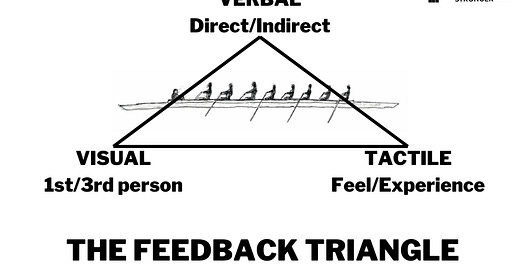I heard a coach use this in a Craftsbury talk last summer, and I’ve thought about and used it regularly ever since. The idea is that we’re connecting or addressing these three main areas with the athlete, or that the self-coached athlete is thinking in these three areas, rather than an over-reliance on one or exclusion of another. (Graphic below link here.)
The athlete should be able to connect what they are feeling with the coaching they are hearing with any video or visual feedback they are seeing. If there’s a disconnect, or one is significantly missing, then we probably aren’t getting the best result.
When I coach, I try to use cues on the water that I know the athlete already understands. Ideally, we’ve talked about and agreed on what the cue means before the session begins, as we’re establishing the technical focus of the session. “We’re working on the front-end mechanics today. When I say ‘hug the horizon,’ that’s the cue for trying to get your handles at least outside the gunnels before the catch, and perhaps even wider if you’re able to.”
Any cue itself doesn’t necessarily make sense without the context of the discussion. Al Morrow tells a great story about coaching an athlete on the “Russian catch drill.” They did the drill, then the athlete was rowing on her own, and Al hollers, “RUSSIAN CATCH!” as she’s passing by to remind her of the drill, to an apparently worse result. The athlete told him later that she thought he was saying, “RUSH-IN catch,” and was trying to really “rush” her blades into the water for the rest of the session!
When we look at video, we come back to the technical focus of the session to process the visual feedback. With our example of front-end mechanics as the focus and “hug the horizon” as our cue, we can look from the stern shot to see if the handles are outside the gunnels at the end of the recovery, and if they stay outside the gunnels as the blades enter the water. Sometimes what we feel or see from the first-person perspective is not actually what we see from an outside perspective or different viewing point.
In order for the learning to stick, the athlete needs to be able to connect what they’re hearing and seeing with what they’re feeling as they do the task. If we don’t make this vital connection, we’ve created an athlete who is dependent on the coach’s verbal feedback or video to know if they are achieving the technique. “What do you feel when you get it right?” When we coached together at WWU, Charlie Hamlin would always say to, “feel the pull between the shoulder blades at the catch,” to give the athlete a tactile cue for suspension.
Like verbal cues, I don’t think the tactile cue itself matters much as long as it makes sense to the athlete. I don’t worry when cues aren't perfectly anatomically or biomechanically accurate. I don’t want the athlete wondering if coach said to feel the lower trapezius or middle trapezius during the stroke, or which one was the posterior deltoid again?
If we aren’t helping the athlete connect at least these three feedback domains through our coaching, then we’re training athletes to be dependent on external feedback to perform. When an athlete asks me, “Did I do that right?” or “Does that look right?" I usually respond with, “What does it feel like to you?” to encourage the athlete to do some of their own processing before I contribute my perspective. If it doesn’t feel different, then it probably isn’t different; if you can’t identify how it feels different, then the learning isn’t going to stick!





